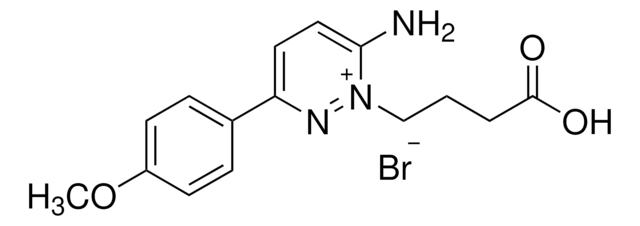165304
D-(–)-2-Amino-5-phosphonopentanoic Acid
≥97% (HPLC), solid, NMDA receptor antagonist, Calbiochem®
Sinonimo/i:
D-(–)-2-Amino-5-phosphonopentanoic Acid, D-AP5, NMDA Antagonist II, APV, D-APV, 2-APV, D-2-amino-5-phosphonovalerate
About This Item
Prodotti consigliati
product name
D-(–)-2-Amino-5-phosphonopentanoic Acid, Active enantiomer of DL-2-amino-5-phosphonopentanoic acid (AP5) that is a commonly used as a competitive NMDA receptor antagonist.
Livello qualitativo
Saggio
≥97% (HPLC)
Forma fisica
solid
Produttore/marchio commerciale
Calbiochem®
Condizioni di stoccaggio
OK to freeze
desiccated (hygroscopic)
protect from light
Colore
white
Solubilità
dilute aqueous base: 1 mg/mL
water: 1 mg/mL
Condizioni di spedizione
ambient
Temperatura di conservazione
2-8°C
InChI
1S/C5H12NO5P/c6-4(5(7)8)2-1-3-12(9,10)11/h4H,1-3,6H2,(H,7,8)(H2,9,10,11)/p-2/t4-/m1/s1
VOROEQBFPPIACJ-SCSAIBSYSA-L
Descrizione generale
Azioni biochim/fisiol
NMDA receptor antagonist
Attenzione
Ricostituzione
Altre note
Schulte, M.K., et al. 1994. Brain Res. 649, 203.
Davis, S., et al. 1992. J. Neurosci. 12, 21.
Note legali
Codice della classe di stoccaggio
11 - Combustible Solids
Classe di pericolosità dell'acqua (WGK)
WGK 3
Punto d’infiammabilità (°F)
Not applicable
Punto d’infiammabilità (°C)
Not applicable
Certificati d'analisi (COA)
Cerca il Certificati d'analisi (COA) digitando il numero di lotto/batch corrispondente. I numeri di lotto o di batch sono stampati sull'etichetta dei prodotti dopo la parola ‘Lotto’ o ‘Batch’.
Possiedi già questo prodotto?
I documenti relativi ai prodotti acquistati recentemente sono disponibili nell’Archivio dei documenti.
I clienti hanno visto anche
Il team dei nostri ricercatori vanta grande esperienza in tutte le aree della ricerca quali Life Science, scienza dei materiali, sintesi chimica, cromatografia, discipline analitiche, ecc..
Contatta l'Assistenza Tecnica.








